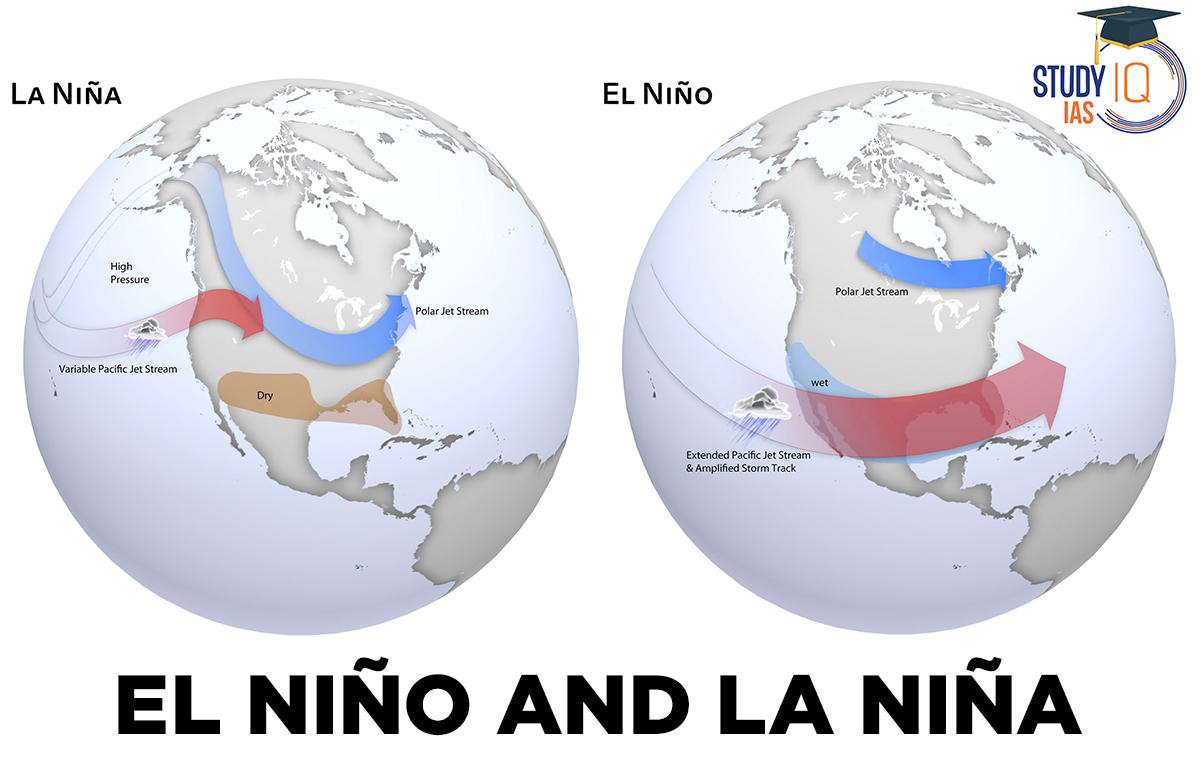Table of Contents
Context: Climate models are predicting a potential return to El Niño by May-July 2023, which may lead to a hot and dry summer in most of India.
More on the News
- Triple Dip La Niña: The world has been experiencing La Niña conditions, which began in September 2020 with a short break in June-August 2021, are still continuing in the equatorial Pacific Ocean.
- This is the first triple-dip La Niña of the 21st century, which is also likely to be the longest on record.
- ‘Triple Dip’ La Niña is a period where the La Niña period extends for up to three consecutive winters.
- ENSO-neutral: According to the latest forecast by NOAA, a transition from La Niña to ENSO-neutral will occur mostly during the February-April 2023 season.
- ENSO-neutral refers to those periods when neither El Ni o nor La Ni a is present. These periods often coincide with the transition between El Ni o and La Ni a events.
- El Niño: The climate models have also predicted a potential return of El Niño conditions by May-July 2023.
About El Niño–Southern Oscillation (ENSO)
- El Niño–Southern Oscillation (ENSO) is an irregular periodic variation in winds and sea surface temperatures over the tropical eastern Pacific Ocean, affecting the climate of much of the tropics and subtropics.
- ENSO has three phases: El Niño, La Niña, and neutral, which are associated with different temperature and atmospheric conditions.
- El Niño occurs when the surface water temperature in the eastern Pacific Ocean becomes warmer than usual, and this warming can last for several months to a few years.
- La Niña occurs when the surface water temperature in the eastern Pacific Ocean becomes cooler than usual, and this cooling can also last for several months to a few years.
- Neutral conditions occur when the sea surface temperatures in the eastern Pacific Ocean are close to average, with no significant warming or cooling.
- Why it happens? The exact causes of ENSO are complex and not fully understood, but scientists believe that changes in ocean and atmospheric circulation patterns, as well as variations in solar radiation and other factors, play a role in triggering and modulating ENSO events.
- Impact of climate change on ENSO:
- Climate change could lead to more frequent and more intense El Niño and La Niña events, which could have a significant impact on global climate patterns.
- Another potential impact is that warmer sea surface temperatures could alter the location and intensity of the Pacific Ocean’s subtropical gyres, which could influence the onset and strength of ENSO events.
El Niño v/s La Niña

| Basis of comparison | El Niño | La Niña |
| Meaning | El Niño means Little Boy, or Christ Child in Spanish. | La Niña means Little Girl in Spanish. |
| Sea surface temperature | It represents the above-average sea-surface temperatures that periodically develop across the east-central equatorial Pacific. | It represents the periodic cooling of sea-surface temperatures across the east-central equatorial Pacific. |
| Pressure | It is laden with high air surface pressure in the western Pacific. | It contain low air surface pressure in the eastern Pacific |
| Mechanism | During El Niño, trade winds weaken. Warm water is pushed back east, toward the west coast of the Americas, resulting in a weaker Walker cell. Cold Peruvian (Humboldt) current gets replaced by warm Elnino (cormwell) current. | During La Niña events, trade winds are even stronger than usual, pushing more warm water toward Asia, resulting in a stronger Walker cell. |
| Period of occurence | Typically occure every 3-5 years and lasts 9-12 months. | Typically occur every 3-5 years and lasts 1-3 years. |
| Impacts |
|
|
| Impact on Indian Monsoon | The monsoon is affected so heavily that 70% reduction of the rainfall is expected. The winds doesn’t carry the moisture towards Indian landmass dueing El Nino causing deficiency in rainfall. | La Nina causes high temperatures over the Indian Ocean, off the Somalian coast and a comparatively better monsoon rains in India. |


 Kargil Vijay Diwas 2024, Date, History a...
Kargil Vijay Diwas 2024, Date, History a...
 SSC CGL Apply Online 2024, Last Date is ...
SSC CGL Apply Online 2024, Last Date is ...
 SSC Stenographer 2024 Notification Out a...
SSC Stenographer 2024 Notification Out a...

















